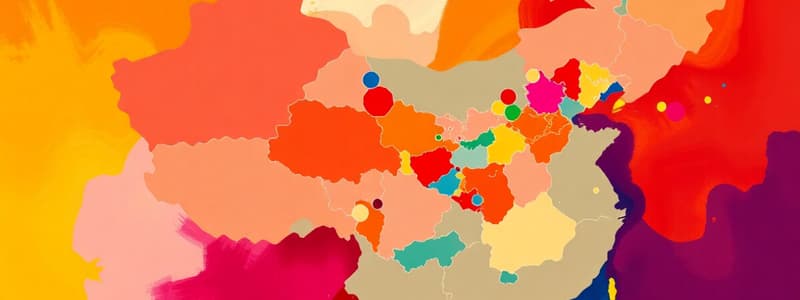Podcast
Questions and Answers
What percentage of the world's population approximately resides in China?
What percentage of the world's population approximately resides in China?
- 15%
- 25%
- 10%
- 20% (correct)
Which region of China receives the highest average yearly precipitation?
Which region of China receives the highest average yearly precipitation?
- Central
- Tibetan Highlands
- South-east (correct)
- North-west
What is the average yearly precipitation in the driest areas of China?
What is the average yearly precipitation in the driest areas of China?
- 500 mm
- 100 mm
- 200 mm
- 50 mm (correct)
How is the relief of China described?
How is the relief of China described?
What is the population of China as mentioned?
What is the population of China as mentioned?
What term is commonly used to describe Tibet due to its elevation?
What term is commonly used to describe Tibet due to its elevation?
What type of landscape primarily characterizes the Tibetan Plateau?
What type of landscape primarily characterizes the Tibetan Plateau?
Which major cities are mentioned as densely populated areas in the east of China?
Which major cities are mentioned as densely populated areas in the east of China?
What environmental conditions contribute to low population density in western China?
What environmental conditions contribute to low population density in western China?
What happens to the ground in Tibet during the summer months?
What happens to the ground in Tibet during the summer months?
Flashcards
China's Population Distribution
China's Population Distribution
China's population is unevenly distributed, concentrated in the east and less populated in the west.
China's Population
China's Population
China has a population of 1.4 billion people.
China's Precipitation
China's Precipitation
China has varying rainfall amounts, with the southeast receiving the most (1000-2000mm per year) and the northwest receiving less (less than 50mm per year).
China's Relief/Mountains
China's Relief/Mountains
Signup and view all the flashcards
Population Density in China
Population Density in China
Signup and view all the flashcards
Tibet's Altitude
Tibet's Altitude
Signup and view all the flashcards
East China's Population
East China's Population
Signup and view all the flashcards
West China's Sparse Population
West China's Sparse Population
Signup and view all the flashcards
Tibet's Landscape
Tibet's Landscape
Signup and view all the flashcards
Tibet's River Source
Tibet's River Source
Signup and view all the flashcards
Study Notes
China: Population and Space
- China's population is 1.4 billion
- Population distribution is uneven, concentrated in the east
- East includes densely populated areas with major cities: Beijing, Shanghai, and Guangzhou
- West is sparsely populated due to harsh natural conditions (dry or high altitude)
- Average precipitation in China is over 600 mm, but varies significantly across the country
- Southeast region receives the most rain (1000-2000 mm annually)
- Northwest region is drier (under 50 mm annually)
- China's terrain is a "staircase" with three main elevations
- Tibetan Highlands (plateau) is at the highest elevation (around 4,500 m)
Population Policy
- China implemented a one-child policy between 1979 and 2015
- The policy aimed to control population growth
- The one-child policy heavily penalized families with more than one child
- The policy resulted in fewer births than expected
- China is now experiencing population aging, with a growing share of elderly citizens
- Life expectancy has increased from 41 years in 1955 to 76.5 years in 2018.
Ethnic Minorities
- Han Chinese live primarily in the east
- Han Chinese are culturally dominant and speak Chinese.
- Other ethnic groups reside in the west
- These groups have unique cultures and languages distinct from the Han Chinese.
- Approximately 100 million Chinese belong to ethnic minorities.
- The Han Chinese migration pattern to other regions is seen as part of a policy by the government of "sinicization"
China: From Copying to Innovating
- China transitioned from a poor country to the world's second-largest economy in four decades.
- Until 1980, all businesses in China were state-owned
- In 1980, China's "open door" policy allowed foreign companies to operate - initially in coastal areas and more recently in inland areas.
Migration and Urbanization
- China experienced massive migration from rural areas to urban centers in the 1980s and onward.
- This migration was driven by economic opportunities in urban areas
- Employment opportunities in cities are greater and often threefold more in comparison to rural areas.
- Urbanization in China is very evident with the increase in cities of over 1 million inhabitants
- A significant portion of the population, estimated at 250 million, are migrant workers who live and work in urban areas without official registration, leading them to be described as the "floating population".
Water in China
- Water distribution in China is uneven with the south being wetter than the North
- Flooding is a significant concern in regions like the Yangtze River. This is due to deforestation.
- Construction of dams and dikes is an attempt to mitigate flooding risks
- Water scarcity is a major issue in the North (especially the Huang He region)
- Water is diverted from the south to support crop irrigation in the north, by the South to North Water Diversion Project
Studying That Suits You
Use AI to generate personalized quizzes and flashcards to suit your learning preferences.




